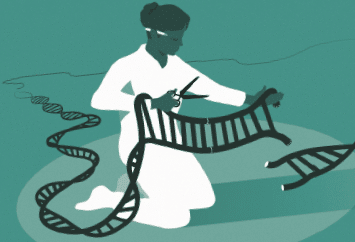For the development of a method for genome editing “CRISPR/Cas9”, The Royal Swedish Academy of Sciences has decided to award the Nobel Prize in Chemistry 2020 to Emmanuelle Charpentier, Max Planck Unit for the Science of Pathogens, Berlin, Germany, and Jennifer A. Doudna, University of California, Berkeley, USA. The announcement marks the first time the award has gone to two women.
Using the method, researchers can change the DNA of animals, plants, and microorganisms with extremely high precision. This technology has had a revolutionary impact on the life sciences, contributes to new cancer therapies, and may make the dream of curing inherited diseases come true.
Researchers need to modify genes in cells if they are to find out about life’s inner workings. Gene editing used to be time-consuming, complicated, and sometimes impossible work. Using the CRISPR/Cas9 genetic scissors, it is now possible to change the code of life over a few weeks.
“There is enormous power in this genetic tool, which affects us all. It has not only revolutionized basic science but also resulted in innovative crops and will lead to ground-breaking new medical treatments,” says Claes Gustafsson, chair of the Nobel Committee for Chemistry.
As so often in science, the discovery of these genetic scissors was unexpected. During Emmanuelle Charpentier’s studies of Streptococcus pyogenes, one of the bacteria that cause the most harm to humanity, she discovered a previously unknown molecule, tracrRNA. Her work showed that tracrRNA is part of bacteria’s ancient immune system, CRISPR/Cas, that disarms viruses by cleaving their DNA.
Charpentier published her discovery in 2011 (Deltcheva et al., 2011). The same year, she collaborated with Jennifer Doudna, an experienced biochemist with vast RNA knowledge. Together, they succeeded in recreating the bacteria’s genetic scissors in a test tube and simplifying the scissors’ molecular components, so they were easier to use.
In an epoch-making experiment, they then reprogrammed the genetic scissors. In their natural form, the scissors recognize DNA from viruses, but Charpentier and Doudna proved that they could be controlled so that they can cut any DNA molecule at a predetermined site (Jinek et al., 2012). Where the DNA is cut, it is then easy to rewrite the code of life.
Since Charpentier and Doudna discovered the CRISPR/Cas9 genetic scissors in 2012, their use has exploded. This tool has contributed to many important discoveries in basic research, translational medicine. Plant researchers have been able to develop crops that withstand mold, pests, and drought.
Biochemist and cell biologists have been investigating the functions of genes and their possible roles in disease progression (Jacinto et al., 2020).
Patients with sickle cell disease are being treated with this revolutionary gene-editing technology (Stein 2020), clinical trials are underway to test the technology in the treatment of childhood blindness (Ledford 2020).

Plant scientists have been using the technology for increasing crop productivity, particularly in advancing breeding in orphan crops (Lemmon et al., 2018). Even some scientists are using CRISPR to revive extinct species, like the woolly mammoth (Revive&Store 2020).
These genetic scissors have taken the life sciences into a new epoch and, in many ways, are bringing the most significant benefit to humankind.
Emmanuelle Charpentier, born 1968 in Juvisy-sur-Orge, France. Ph.D. 1995 from Institut Pasteur, Paris, France. Director of the Max Planck Unit for the Science of Pathogens, Berlin, Germany.
Jennifer A. Doudna, born 1964 in Washington, D.C, USA. Ph.D. 1989 from Harvard Medical School, Boston, USA. Professor at the University of California, Berkeley, USA and Investigator, Howard Hughes Medical Institute.















